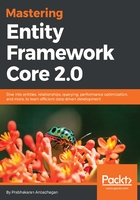
上QQ阅读APP看书,第一时间看更新
Configuring data context
The auto-generated database context (which is presented in the following code) will include:
- Virtual properties of the tables/entities to hold corresponding data.
- The OnConfiguring method, which will configure EF with the database.
- The OnModelCreating method, which will ensure certain constraints and relationships are built while creating the database. It would not be used in our database-first approach as we already have them in place.
The database context should contain the following configuration:
public partial class MasteringEFCoreDbFirstContext : DbContext
{
public virtual DbSet<Blog> Blog { get; set; }
public virtual DbSet<Post> Post { get; set; }
protected override void OnConfiguring(DbContextOptionsBuilder
optionsBuilder)
{
if (!optionsBuilder.IsConfigured)
{
// Move this connection string to config file later
ptionsBuilder.UseSqlServer(@"Server=
(localdb)\mssqllocaldb;Database=MasteringEFCoreDbFirst;
Trusted_Connection=True;");
}
}
protected override void OnModelCreating(ModelBuilder
modelBuilder)
{
modelBuilder.Entity<Post>(entity =>
{
entity.HasIndex(e => e.BlogId).HasName("IX_Post_BlogId");
entity.Property(e => e.Title).IsRequired();
entity.HasOne(d => d.Blog).WithMany(p => p.Post)
.HasForeignKey(d => d.BlogId);
});
}
}
In case you have noticed the warning, we need to remove the section using dependency injection, which will be performed in the Registering Context in Services (.NET Core DI) section.